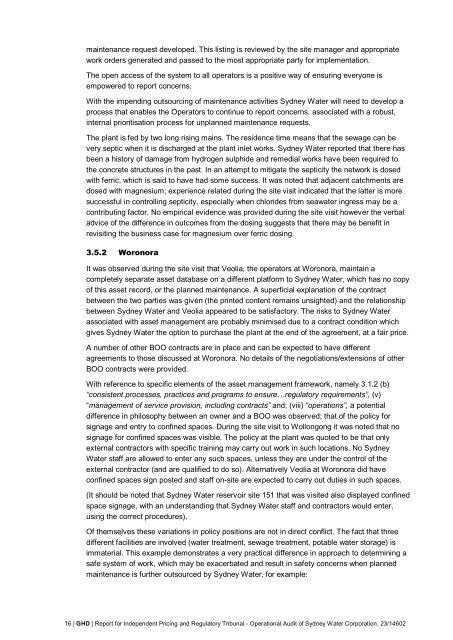Sydney Water Operational Audit 2011/2 - IPART - NSW Government
Sydney Water Operational Audit 2011/2 - IPART - NSW Government
Sydney Water Operational Audit 2011/2 - IPART - NSW Government
You also want an ePaper? Increase the reach of your titles
YUMPU automatically turns print PDFs into web optimized ePapers that Google loves.
maintenance request developed. This listing is reviewed by the site manager and appropriate<br />
work orders generated and passed to the most appropriate party for implementation.<br />
The open access of the system to all operators is a positive way of ensuring everyone is<br />
empowered to report concerns.<br />
With the impending outsourcing of maintenance activities <strong>Sydney</strong> <strong>Water</strong> will need to develop a<br />
process that enables the Operators to continue to report concerns, associated with a robust,<br />
internal prioritisation process for unplanned maintenance requests.<br />
The plant is fed by two long rising mains. The residence time means that the sewage can be<br />
very septic when it is discharged at the plant inlet works. <strong>Sydney</strong> <strong>Water</strong> reported that there has<br />
been a history of damage from hydrogen sulphide and remedial works have been required to<br />
the concrete structures in the past. In an attempt to mitigate the septicity the network is dosed<br />
with ferric, which is said to have had some success. It was noted that adjacent catchments are<br />
dosed with magnesium; experience related during the site visit indicated that the latter is more<br />
successful in controlling septicity, especially when chlorides from seawater ingress may be a<br />
contributing factor. No empirical evidence was provided during the site visit however the verbal<br />
advice of the difference in outcomes from the dosing suggests that there may be benefit in<br />
revisiting the business case for magnesium over ferric dosing.<br />
3.5.2 Woronora<br />
It was observed during the site visit that Veolia, the operators at Woronora, maintain a<br />
completely separate asset database on a different platform to <strong>Sydney</strong> <strong>Water</strong>, which has no copy<br />
of this asset record, or the planned maintenance. A superficial explanation of the contract<br />
between the two parties was given (the printed content remains unsighted) and the relationship<br />
between <strong>Sydney</strong> <strong>Water</strong> and Veolia appeared to be satisfactory. The risks to <strong>Sydney</strong> <strong>Water</strong><br />
associated with asset management are probably minimised due to a contract condition which<br />
gives <strong>Sydney</strong> <strong>Water</strong> the option to purchase the plant at the end of the agreement, at a fair price.<br />
A number of other BOO contracts are in place and can be expected to have different<br />
agreements to those discussed at Woronora. No details of the negotiations/extensions of other<br />
BOO contracts were provided.<br />
With reference to specific elements of the asset management framework, namely 3.1.2 (b)<br />
“consistent processes, practices and programs to ensure…regulatory requirements”, (v)<br />
“management of service provision, including contracts” and; (viii) “operations”, a potential<br />
difference in philosophy between an owner and a BOO was observed; that of the policy for<br />
signage and entry to confined spaces. During the site visit to Wollongong it was noted that no<br />
signage for confined spaces was visible. The policy at the plant was quoted to be that only<br />
external contractors with specific training may carry out work in such locations. No <strong>Sydney</strong><br />
<strong>Water</strong> staff are allowed to enter any such spaces, unless they are under the control of the<br />
external contractor (and are qualified to do so). Alternatively Veolia at Woronora did have<br />
confined spaces sign posted and staff on-site are expected to carry out duties in such spaces.<br />
(It should be noted that <strong>Sydney</strong> <strong>Water</strong> reservoir site 151 that was visited also displayed confined<br />
space signage, with an understanding that <strong>Sydney</strong> <strong>Water</strong> staff and contractors would enter,<br />
using the correct procedures).<br />
Of themselves these variations in policy positions are not in direct conflict. The fact that three<br />
different facilities are involved (water treatment, sewage treatment, potable water storage) is<br />
immaterial. This example demonstrates a very practical difference in approach to determining a<br />
safe system of work, which may be exacerbated and result in safety concerns when planned<br />
maintenance is further outsourced by <strong>Sydney</strong> <strong>Water</strong>, for example:<br />
16 | GHD | Report for Independent Pricing and Regulatory Tribunal - <strong>Operational</strong> <strong>Audit</strong> of <strong>Sydney</strong> <strong>Water</strong> Corporation, 23/14602
















